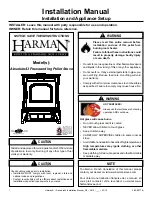
16
Encore Woodburning Stove
30003842
High-Efficiency Wood Burning with
Catalytic Combustion
An Encore leaves the factory with the combustor in-
stalled.
In the United States, it is against the law to operate this
wood heater in a manner inconsistent with operating
instructions in this manual, or if the catalytic combustor
is deactivated or removed. The components of the cata-
lytic combustion system in your Encore work together to
produce optimum conditions for secondary combustion.
When the damper is closed, smoke travels through
the catalytic element, which causes ignition of smoke
at temperatures of 260-315° C (500-600° F), half the
temperature normally required for unaided secondary
combustion.
The catalytic element is a ceramic “honeycomb” coated
with the catalytic material. The element is located in the
secondary combustion chamber, molded from a special
high-temperature insulating refractory material. The
chamber provides the correct environment necessary
for secondary combustion of the fuel (smoke).
Closing the damper exposes the smoke to the combus-
tor. If the combustor is at least 316° C (600° F), it will
begin to burn the smoke.
Closing the stove damper may also reduce the draft,
so to avoid putting out the fire or deactivating the
combustor, close the damper only when a fire is well-
established. When starting a fire, wait until the fire is
well established and there is an ember bed of at least
76-102 mm (3-4”) before closing the damper.
Never kindle a fire with colored paper or paper that
has colored ink or a glossy surface, and never burn
treated wood, garbage, solvents, or trash. All of these
may poison the catalyst and prevent it from operating
properly. Never burn cardboard or loose paper except
for kindling purposes. Never burn coal; doing so can
produce soot or large flakes of char or fly ash that can
coat the combustor and cause smoke to spill into the
room. Coal smoke also can poison the catalyst so that it
won’t operate properly.
In general, the fire must be sufficiently well-established
to ensure that catalytic activity is initiated. When first
starting a fire, a medium- to high- firing rate must be
maintained until the stove, catalyst, and fuel are all
stabilized at the proper operating temperatures.
Even though it is possible for the fire to get quite hot
within a few minutes after a fire is started, the combus-
tor may stop working or the fire may go out if the fire
is allowed to die down immediately as a result of the
damper being closed. Once the combustor starts work-
ing, heat generated by burning the smoke will keep it
working.
To determine whether the combustor is operating, ob-
serve the amount of smoke leaving the chimney when
the damper is activated and when it is not. This proce-
dure is described on Page 27.
Avoid using a full charge of very dry wood in the fire-
box. This may result in continuous very high tempera-
tures in the secondary combustion area and damage
the combustor. Wood which has been split, and stored
under cover for more than 18 months may be consid-
ered very dry. Also, do not use a full load of dry slab
wood or scrap wood. For long burns, use a mix of dry
and moderately dry wood.
Conditioning Your Stove
Cast iron is extremely strong, but it can be broken with
a sharp blow from a hammer or from the thermal shock
of rapid and extreme temperature change.
The cast plates expand and contract with changes in
temperature. When you first begin using your Encore,
minimize thermal stress by allowing the plates to adjust
gradually during three or four initial break-in fires follow-
ing Steps 1-3 below.
Starting and Maintaining a Wood Fire
Burn only solid wood in the Encore, and burn it directly
on the grate. Do not elevate the fuel. Do not burn coal
or other fuels.
The damper must be open when starting a fire or
when refueling.
Do not use chemicals or fluids to start the fire. Do
not burn garbage or flammable fluids such as gaso-
line, naptha, or engine oil.
1. Open the stove damper, and open the primary air
control fully.
2. Place several sheets of crumpled newspaper in the
stove.
DO NOT
use glossy advertisements or col-
ored paper, as they can poison the catalyst. Place
on the paper six or eight pieces of dry kindling split
to a finger-width size, and on the kindling lay two or
three larger sticks of split dry wood approximately
25-51 mm (1-2”) in diameter.
ST263
starting a fire
12/99
ST263
Fig. 25
Start fire with newspaper and dry kindling.
















































